| Article ID | Journal | Published Year | Pages | File Type |
|---|---|---|---|---|
| 3377472 | Journal of Infection and Chemotherapy | 2007 | 5 Pages |
Because Acinetobacter baumannii has become an alarming endemic pathogen in our country we decided to conduct this prospective study, from January 2004 to December 2005, in order to determine risk factors and outcomes involved in clinical colonization or infection by A. baumannii in a 16-bed Tunisian intensive care unit (ICU). One hundred and two A. baumannii isolates were obtained from 63 patients, with an infection rate of 45%. The rate of multidrug-resistant (MDR) A. baumannii was 39% during the 2-year study, with an epidemic outbreak in October 2004. This outbreak was followed by closure of all the involved ICU rooms and the selective intestinal decontamination of patients, with polymyxin. During the 12-month post-intervention program (January–December 2005), the infection rate declined. The analysis of risk factors for the spread of A. baumannii showed that only the Simplified Acute Physiological Score (SAPS II) was involved. On the other hand, no risk factor was identified for multidrug resistance in patients either colonized or infected by A. baumannii. There was a statistically significant difference only in crude mortality (67.5% in MDR A. baumannii vs 46.7% in susceptible A. baumannii; P = 0.04).
